Jason Mann, UK Head of Product at Ticketer, talks through some of Ticketer’s most notable innovations of 2020, and how we are aiming to make life as simple as possible for operators and passengers alike.
I don’t think there is any need for me to say how much we were disrupted in our day-to-day lives during 2020. From plummeting passenger numbers to meetings taking place over video conferencing, every aspect of life as we knew it changed during 2020. But we are proud to say that one thing did remain constant, and that was the regular and continual ETM and portal upgrades that Ticketer customers have been familiar with.
But what we did miss last year were being able to catch up with our old, and new, operators at the various trade shows and events that we regularly attended. These events and shows were always great opportunities, not only to catch up with our operators, but also to showcase some of our new features, and we realise that without this avenue, some of the hard work our development teams have been focused on, may have gone unnoticed.
So, as we start a new year – a year we hope will end up much better than the last one, we felt it was a good opportunity to take a retrospective look at the developments that we had released during 2020, just in case there was something in there that you may have missed!
You can hear directly from Jason in the video above or have a read of each section below:
PASSENGER OCCUPANCY
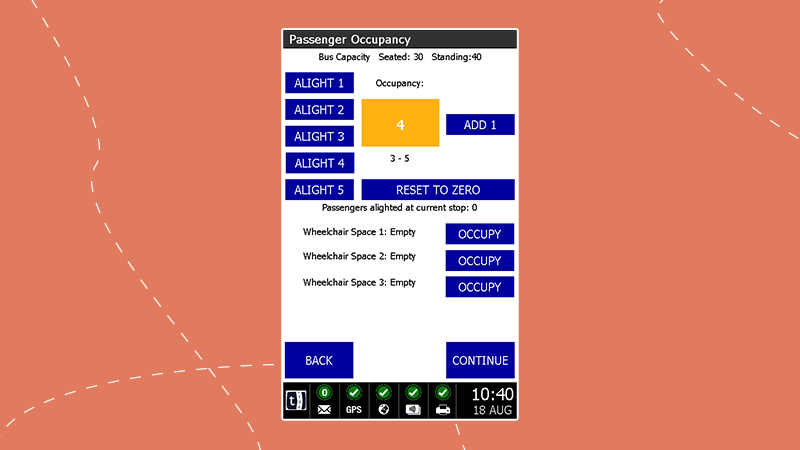
It should be no surprise that I start this review by discussing our Passenger Occupancy feature. We recognised early on that social distancing on buses could present issues and so we mobilised quickly to develop an enhancement to the ETM to allow the driver to quickly and efficiently count passengers off which then allowed the ETM to maintain a count of how many passengers were on board, primarily for the driver’s benefit so they could always see how many people were on board without having to leave their cab. But that wasn’t the end of that feature. We extended it to also count when the wheelchair spaces were occupied. We developed an extension to SIRI to forward this information onto third party systems such as mobile apps. Passengers could also see this information as the bus approached the bus stop via an integration with Hanover Destination Displays and we extended the back office to collect and display this data.
Covid-19 Bus Service Support Grant (CBSSG)
That wasn’t the only Covid related development of course. Earlier in the pandemic, we worked closely with the DfT on being able to generate the Covid-19 Bus Service Support Grant directly from the Ticketer System thus making it easier for Ticketer operators to be able to meet the necessary data requirements in order to qualify for the grant and avoiding spending hours collating the necessary data to do so.
Another example of working closely with the DfT to support our operators which continued throughout 2020 was in our support of the Bus Open Data Initiative – more of which later.
EMV CONTACTLESS LIMITS AND APPLE PAY EXPRESS

An earlier Covid development of course, was supporting the increased limits for using contactless EMV cards which was increased from £30 to £45 which we delivered in time for the change to take effect on the 1st of April even though we only had a couple of weeks’ notice that the change was coming.
That wasn’t our only contactless EMV change in 2020. We also worked with Apple to support ApplePay Express for both tap transactions and retail transactions, thereby removing the need for passengers to unlock their phones with face ID when using this method of payment on bus. Avoiding using FaceID to unlock the phone also meant that passengers didn’t need to remove their face masks when paying this way. We had no idea when we started to engage with Apple on this that this would be the primary driver for this feature!
QR CODE READER ENHANCEMENTS
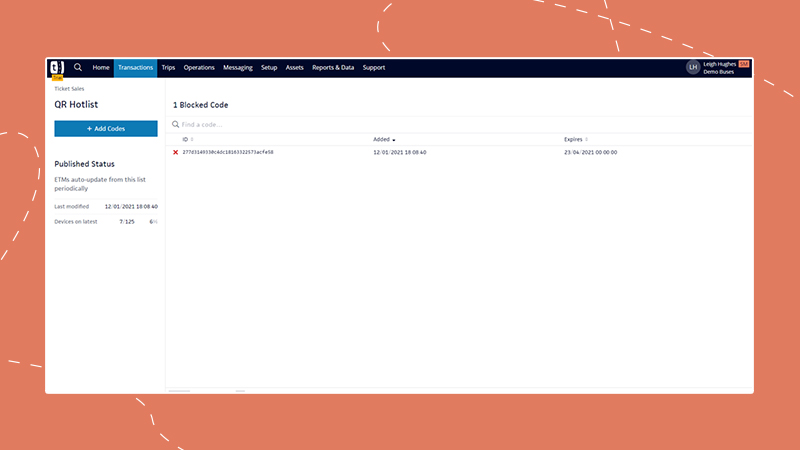
Recognising that contactless methods of ticketing were key during the pandemic, we also enhanced our solution with regard to accepting QR codes.
- We extended our paper QR schema to provide a more robust way to manage multi-operator QR codes to help with the increasing number of multi-operator schemes we started to see emerge.
- We introduced the ability to hotlist QR codes from the portal, so QR codes, like ITSO cards and EMV cards could be declined by the ETM should the operator suspect fraudulent use or through lost paper tickets (who had thought that would have been possible a few years ago!).
- And we introduced the ability to report on any failed QR usage, for example, should the QR code be expired, not valid on that particular service or even when blocked.
INCIDENT MANAGEMENT FEATURE ENHANCEMENTS
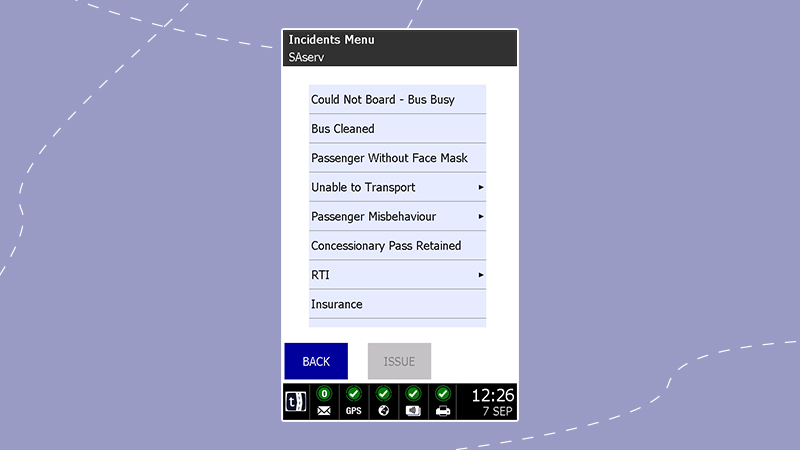
Another of the Ticketer features that gained increase use during the pandemic was our Incident Management feature – where we have extended the existing Insurance button to be able to print advisory slips for any multitude of reasons – a topical example being recording when passengers were not wearing face masks. Recognising its wider usage, we extended this capability to not require an advisory slip to be printed. So if you wanted the drivers to record when the bus could not pick up further passengers at a stop due to the bus being full, the driver could issue an incident of ‘COULD NOT PICK UP’ incident which would simply record the event which could be reported on in the back office.
We also added the ability for these incidents to be included in a SIRI feed to third-party systems, such as apps. So, if you wanted your app to know when the vehicle had been deep clean mid-service, this could be added as an ‘incident’ and would be forwarded to any SIRI feed anytime this event was issued. This was implemented in a purely generic way, so this could be applied to any incident any operator wanted to define.
Of course, we also found time to implement some non-COVID developments!
DESTINATION DISPLAY INTEGRATIONS
At the end of 2019 (which seems like a lifetime ago now!), we were demonstrating our ability to integrate with Hanover and Mobitec destination displays. We have added enhancements to both of these last year; as well as adding passenger occupancy information to the Hanover destination display which was mentioned earlier, we also added a departure countdown feature to Mobitec destination displays. Not only that we also added support for a third supplier; Aesys destination displays and AV screens, all of which can be driven by Ticketer ETMs.
Whilst on the topic on on-bus integrations, we know that the reality is that many operators may have different equipment from different suppliers on different vehicles and so we quickly realised that managing hardware differences when connecting to different equipment on different buses with per ETM configurations was going to be complex, time-consuming and sub-optimal and so we developed Vehicle Config Profiles, which allows operators to define what equipment is on what bus. Whilst this enhancement was driven from the need to support different destination display equipment, the development is generic and can be applied to any hardware that the ETM may connect to.
VEHICLE CHECKLIST ENHANCEMENTS
Whilst on the subject of vehicle related developments, our vehicle checklist feature had a number of enhancements added to it during last year from the ability to augment any reported defects with additional notes from the portal to extending the reports to include vehicles checked, not just those with any reported defects.
But the biggest change was the introduction of an API that can be used by fleet management systems to receive data regarding reported defects from the Ticketer system into the fleet management system, but equally can also pass back from the fleet management system, details about any defects that have been rectified, therefore avoiding the re-keying of data between the two systems in managing engineer’s tasks. This key development is a major efficiency gain if, as an operator, you are using a fleet management system to manage engineer jobs and workloads.
ADDITIONAL NEW DEVELOPMENTS
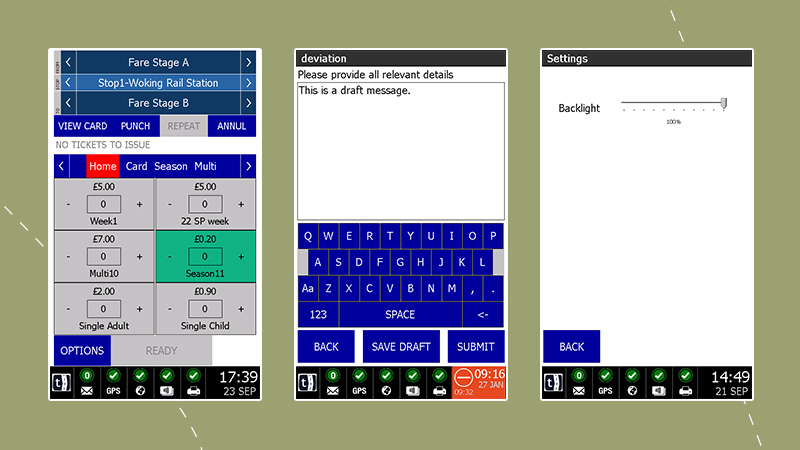
Now I appreciate at this stage some of you may be dropping off here and I have only just scratched the surface of some of the new developments we added during 2020. You’ll be pleased to hear that I won’t into detail of all of them (thankfully I hear you all say), so I’ll do a quick roll call to call out some of the additional notables:
- The ability to define a “home” screen on the ETM per service or set of services which would include those popular tickets for that service.
- Being able to save a draft of driver messages on the ETM and being able to see any messages sent that day per driver.
- Manual screen dimming controls.
- Support for the ITSO STR capping scheme in the Nottingham area.
- Enhancements to coupons to issue per transaction, not per ticket and the ability to print third party QR codes onto Coupons.
- Additional fields to our ticket and trip exports when importing the Ticketer data into data warehouse systems.
- A new look menu for the portal.
- Recording events when entering and exiting defined depot geofences.
- Trip measurements which we will start to make more use of this year.
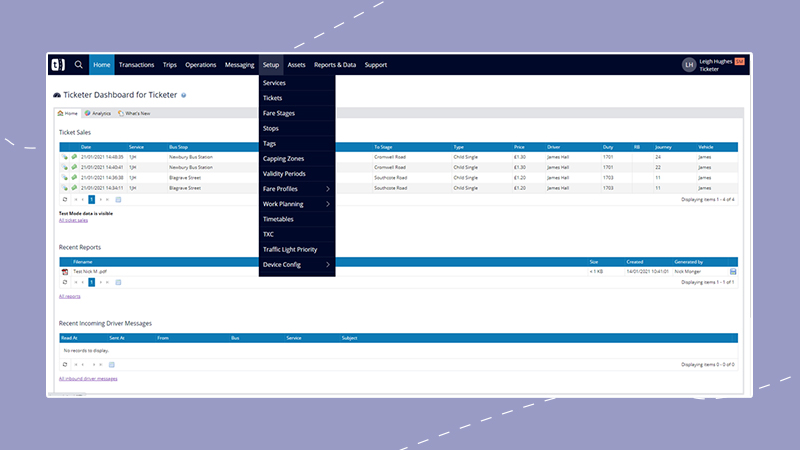
… The list goes on.
I am pleased to say that despite what last year had thrown at us, we have been continually upgrading the portal and making ETM upgrades available to operators. And will continue to so.

